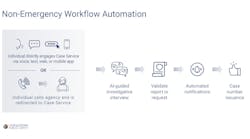Law enforcement has moved into an increasingly paperless environment. The days when an officer pulled out a triplicate form to write a report are in the past. Officers who have some years under their belt reminisce about the evolution. “I have lived the lifecycle of carbon paper through to the infancy of going paperless (word processor with printing) to where Summerville is now a paperless agency,” explains Officer Rob Christie, Summerville (SC) Police/Fire Department. With more than 20 years in the business, he remembers the integration of electronic report writing software (RWS), aka field reporting. Much like the difference between an Atari game system and a Wii, this software has grown in leaps and bounds from its first generation. This growth doesn’t appear to be stopping anytime soon as RWS developers continue to make improvements.
Evolution of RWS
In the beginning there were a number of issues with RWS and not just with the technology. The main issue was resistance to change. “If we go back to our first generation, the biggest issues weren’t the software, but the officer and staff,” says Christie. “They had only known paper so moving them to a virtual world was a bit cumbersome. I remember the time after our ‘cut over day’. The officers would type their report, print it, give it to someone to read and edit and then submit it electronically. This was all because they weren’t used to reading and editing on the screen.” Lieutenant Ken Plunkett, West Covina (CA) Police Department agrees, “Transition was a little difficult because it looked and felt different to us as officers. It was kind of hard for us to adapt at first.”
Officer designers
RWS was originally designed from the developer’s viewpoint. “The people who were creating it had a focus on what it needed to do and a vision as to what it should look and feel like,” explains Plunkett. “I think the original versions were not so user friendly because it didn’t really come from the users. It came from the developers. Once we started seeing it, using it and providing some feedback, it evolved into something that we were all happy with using.” Brian Pugh, product line manager at Spillman Technologies, which was recently purchased by Motorola, agrees—designers did not recognize the true end-user in developing RWS. “In the past it was designed more (for) a records clerk (and) the information they would need to gather.” Developers at Spillman, which serves over 1,700 agencies, studied the environment an officer works in and what information they need to gather to improve their product.
Mirror image
To deal with the resistance to change, some first generation RWS attempted to mimic the paper forms officers were used to. “What people did was take word documents and form templates of their exact form,” states Tony White, West Covina Service Group (WCSG). A unique developer started by the city and police department in the 1990s, they purchased the source code, hired programmers and started building a product which includes a hosted environment so customers don’t have to have their own hardware or servers. Their RWS literally grew from the end-users out to their customer base. “Once our reports started looking and feeling like our normal reports that we used to write on, the guys saw the benefits of it,” Plunkett states. Now officers are more tolerant of electronic forms without it being a mirror image.
New RWS is also built on a better architectural base with advanced technology. It can be easily customizable, unlike first generation software. “Field reporting (used) to be too static, too hard to change,” explains Pugh. “It was cumbersome for the officer to use and then cumbersome for supervisors to review.” He also indicates overall stability wasn’t ideal. “The load time to open up a form was slow,” he says. It was common for it to crash and the officer to lose all the data they had been working on.
New generation “techies”
Along with finding ways to sell the seasoned officers on RWS, the new generation of officers had to be considered as well. “As you bring new law enforcement folks into the fold, people are more used to pre-filled forms online, like booking a hotel or buying something,” says White. Using drop-down menus and fillable e-forms on a variety of electronics is commonplace to these officers. “The new generation, all the newer officers we’re hiring, they’re all computer savvy and everyone wants technology,” Plunkett states. “Everybody has had a smartphone. As the software evolves, I think being able to let officers use iPads or tablets of some sort will make it even more mobile.” RWS continues to expand in application. “The investment in keeping your employees happy, staying up with technology and attracting people to your agency with technology advances like that is super important,” he explains.
Integrated systems
Newer RWS integrates with a number of other systems, including records management systems (RMS). This integration allows for complicated report generating and advanced searching. “A good field reporting system will tie together your CAD system, so the officers will be able to pull information from the CAD call, and use that information to fill it out,” Pugh says. “They’re going to be able to start off that property and evidence process for the evidence technician and then the information is going to be standardized for the investigators so the investigators will know exactly what is going to be in that report.” Another integrated benefit is the ability to send the report remotely to the supervisor for review. “The officer can send the report, scan and send documents, collect evidence and add those elements,” states White. “All of those items are reviewed by the supervisor to make sure that the report is thorough and can be presented in court or to investigations for further follow-up.” As it evolves, RWS will also be able to integrate a log of radio communication and video from body worn cameras. These integrated systems will also increase officer safety. “Whenever you search for someone in our system, officer safety concerns are highlighted immediately,” explains Scott Crouch, CEO, Mark43. “Having that information at the fingertips of first responders is going to increase their safety pretty dramatically.” Mark43 currently serves 40 agencies across the metro-Washington D.C. area and is working with the South Bay Regional Public Communications Authority (RCC) in Hawthorne (CA) to upgrade its system, which serves five South Bay police departments. Integrated systems bring together all the information officers need. “I think that the future of law enforcement software itself will be one single platform for all of those,” explains Crouch. Everything from CAD to evidence systems to detective case management should be a seamless extension of your records system. “That’s really what we try to build because all of that information should flow between the platforms,” he states.
Integrated jurisdictions
Integrated systems are not the only integration RWS lends itself too. Like Washington D.C. and RCC, multiple jurisdictions are sharing software. “RWS by pure virtue of the fact that it is capturing information into databases allows for the sharing of data between jurisdictions,” says White. Crouch explains how sharing between agencies, in particular with a cloud-based RWS makes even more sense due to the nature of American policing. “America has more than 17,000 police departments which is really pretty different than most foreign countries. With our number of police forces we need a cloud-based system that allows jurisdictions to share information.” Both Amazon and Microsoft now have CJIS-compliant cloud systems. “I think that is really going to drive sharing of information,” Crouch says. Cost is also a benefit to sharing. “Not only does it make implementation easier but it brings cost down in some cases,” explains Crouch. Pugh agrees, “Nowadays, it’s almost uncommon for a single agency to be buying a system. It’s most often a multi-agency, multi-jurisdictional purchase.”
Continued efficiency
Arguably the largest benefit to RWS is that it keeps officers out of the station and in the field. Officers respond from street corners in their beat rather than the station. As RWS evolved, standardization, auto-fill boxes and ease of use has increased efficiency even more. “If you start typing in something that’s familiar to the computer, it may self-populate,” Plunkett says. “It does cut down on time, especially like using the station address or things that are pretty common for most reports. Metropolitan Police Department (Washington D.C.), an agency that transitioned to Mark43 RWS a little more than two years ago has seen measurably increased efficiency and savings. “What we saw was that we were able to save Washington D.C. Metro Police about 238,000 hours a year in report times,” Crouch explains. “It’s the equivalent of them hiring an addition 110 officers.” Another area of improved efficiency is reducing duplicate work. The records clerk or evidence technician no longer has to rekey in the officer’s information, explains White. This also increases accuracy. “The officer is the first line of data collection for the agency,” says Pugh. “In the past, they were filling out information in their notepad or filling out a report by hand, then somebody else had to go back in after the fact and enter all that information into their records management system.” RWS allows the officer, the first hand witness, to enter their information exactly as intended. Christie confirms this stating the auto-populated, required fields across the multiple screens and reports has cut their agency’s processing time from officer entry to records clerk validation by over 90 percent.
Pugh states his company expects their officers to be able to sit down and within a few minutes know how to fill out any of their field reports. With the concern over officer deaths due to having their attention drawn away from their surroundings, intuitive, standardized RWS is essential. “It’s not something that takes all of their attention,” says Pugh. “They’re not pouring into a computer screen unaware of their surroundings. Because of it being intuitive it allows them to still maintain awareness of their surroundings while they are filling out that report.”
Cost and value
As far as price, not much has changed. What has is the value. White explains that a product can now be enhanced and built quicker than ever before. Pugh agrees the maintenance of cost is actually a positive thing, “With all the advancements and the new technology we’ve managed to keep the price the same over the years from our older out-dated field reports.”
Crouch is an advocate of their cloud-based model stating pricing on a subscription system makes more financial sense. “I think that the old way of pricing these systems is not going to work for much longer. One of the beautiful things about a subscription model for this software is that you’re getting updates that are included in your subscription price. They’re being rolled out seamlessly through the cloud. You don’t have to go through an upgrade where you have to pay millions of dollars.”
Platforms
In regards to platforms, the jury is still hung on whether on-premise or cloud-based RWS is ideal. Pugh argues that on-premise is superior because it allows agencies to control their own server and information. Crouch disagrees, exerting cloud-based is the next evolution. With the new CJIS-compliant products, he believes the cloud is absolutely critical to advancing this industry into the future. “It’s no longer as safe or secure or as reliable to put these systems on premise than it is to trust Amazon or Microsoft or to spend billions of dollars in security to host that information,” he explains. Either way, agencies need to keep in mind the updates, upgrades and improvements that are necessary for a good system. Ability to continue to customize based on what the agency or the individual state needs must be considered as well, states Pugh. Agencies need to do their research to find the best fit.
“This is the evolution of society and as major corporations have or are trying to streamline their processes, so are law enforcement agencies,” says Christie. “Like here at our department, most are looking at how they can serve the community more timely and efficiently.” Agencies with well-developed, evolving RWS will not only be able to do their jobs accurately and efficiently but will also be good finance stewards of their community’s money. “I think that one of the things that we at least try to do is really leverage a complete overhaul of what RMS should be,” Crouch says. “How officers should interact with data. How they should write a report. Make it a really responsive design that can be used off any device. Really bring it up to the standards of how software should be built in 2017.” This way, officers can go back to using their pens to rewind cassette tapes.



